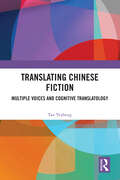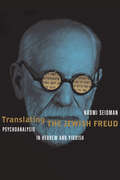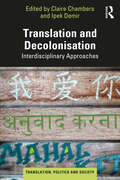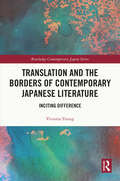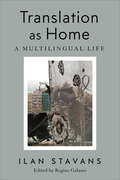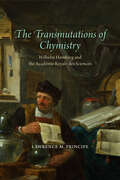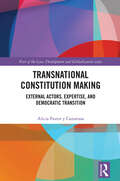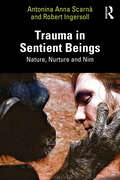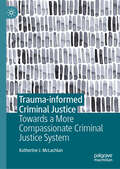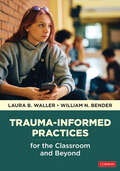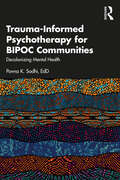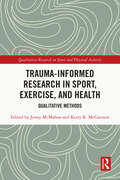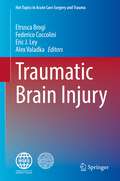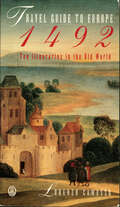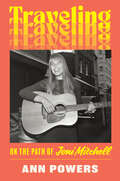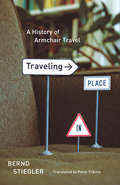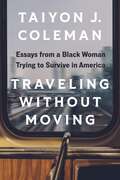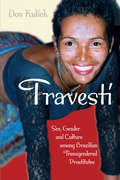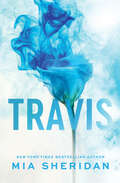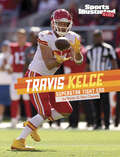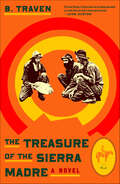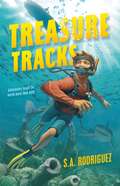- Table View
- List View
Translating Chinese Fiction: Multiple Voices and Cognitive Translatology
by Tan YeshengDrawing on the cognitive translatological paradigm, this book introduces a situation-embedded cognitive construction model of translation and explores the thinking portfolios of British and American sinologists-cum-translators to re-examine their multiple voices and cognition in translating Chinese fiction.By placing sinologists-cum-translators in the same discourse space, the study transcends the limitations of previous case studies and offers a comprehensive cognitive panorama of how Chinese novels are rendered. The author explores the challenges and difficulties of translating Chinese fiction from the insider perspectives of British and American sinologists, and cross-validates their multiple voices by aligning them with cross-cultural communication scenarios. Based on the cognitive construction model of translation, the book provides a systematic review of the translation thoughts and ideas of the community of sinologists in terms of linguistic conventions, narrative styles, contextual and cultural frames, readership categories and metaphorical models of translation. It envisions a new research path to enhance empirical research on translators' cognition in a dynamic translation ecosystem. The title will be an essential read for students and scholars of translation studies and Chinese studies. It will also appeal to translators and researchers interested in cognitive stylistics, literary studies and intercultural communication studies.
Translating the Jewish Freud: Psychoanalysis in Hebrew and Yiddish (Stanford Studies in Jewish History and Culture)
by Naomi SeidmanThere is an academic cottage industry on the "Jewish Freud," aiming to detect Jewish influences on Freud, his own feelings about being Jewish, and suppressed traces of Jewishness in his thought. This book takes a different approach, turning its gaze not on Freud but rather on those who seek out his concealed Jewishness. What is it that propels the scholarly aim to show Freud in a Jewish light? Naomi Seidman explores attempts to "touch" Freud (and other famous Jews) through Jewish languages, seeking out his Hebrew name or evidence that he knew some Yiddish. Tracing a history of this drive to bring Freud into Jewish range, Seidman also charts Freud's responses to (and jokes about) this desire. More specifically, she reads the reception and translation of Freud in Hebrew and Yiddish as instances of the desire to touch, feel, "rescue," and connect with the famous Professor from Vienna.
Translation and Decolonisation: Interdisciplinary Approaches (Translation, Politics and Society)
by Claire Chambers Ipek DemirTranslation and Decolonisation: Interdisciplinary Approaches offers compelling explorations of the pivotal role that translation plays in the complex and necessarily incomplete process of decolonisation. In a world where translation has historically been a tool of empire and colonisation, this collection shines the spotlight on the potential for translation to be a driving force in decolonial resistance. The book bridges the divide between translation studies and the decolonial turn in the social sciences and humanities, revealing the ways in which translation can challenge colonial imaginaries, institutions, and practice, and how translation opens up South-to-South conversations. It brings together scholars from diverse disciplines and fields, including sociology, literature, languages, migration, politics, anthropology, and more, offering interdisciplinary approaches and perspectives. By examining both the theoretical and practical aspects of this intersection, the chapters of this agenda-setting collection explore the impact of translation on decolonisation and highlight the need to decolonise translation studies itself. The book illuminates the transformative power of translation in transcending linguistic, cultural, and political boundaries.
Translation and the Borders of Contemporary Japanese Literature: Inciting Difference (Routledge Contemporary Japan Series)
by Victoria YoungThis book examines contemporary debates on such concepts as national literature, world literature, and the relationship each of these to translation, from the perspective of modern Japanese fiction.By reading between the gaps and revealing tensions and blind spots in the image that Japanese literature presents to the world, the author brings together a series of essays and works of fiction that are normally kept separate in distinct subgenres, such as Okinawan literature, zainichi literature written by ethnic Koreans, and other “trans-border” works. The act of translation is reimagined in figurative, expanded, and even disruptive ways with a focus on marginal spaces and trans-border movements. The result decentres the common image of Japanese literature while creating connections to wider questions of multilingualism, decolonisation, historical revisionism, and trauma that are so central to contemporary literary studies.This book will be of interest to all those who study modern Japan and Japanese literature, as well as those working in the wider field of translation studies, as it subjects the concept of world literature to searching analysis.
Translation as Home: A Multilingual Life
by Ilan StavansTranslation as Home is a collection of autobiographical essays by Ilan Stavans that eloquently and unequivocally make the case that translation is not only a career, but a way of life. Born in Mexico City, Ilan Stavans is an essayist, anthologist, literary scholar, translator, and editor. Stavans has changed languages at various points in his life: from Yiddish to Spanish to Hebrew and English. A controversial public intellectual, he is the world’s authority on hybrid languages and on the history of dictionaries. His influential studies on Spanglish have redefined many fields of study, and he has become an international authority on translation as a mechanism of survival. This collection deals with Stavans’s three selves: Mexican, Jewish, and American. The volume presents his recent essays, some previously unpublished, addressing the themes of language, identity, and translation and emphasizing his work in Latin American and Jewish studies. It also features conversations between Stavans and writers, educators, and translators, including Regina Galasso, the author of the introduction and editor of the volume.
The Transmutations of Chymistry: Wilhelm Homberg and the Académie Royale des Sciences (Synthesis Ser.)
by Lawrence M. DeMartinoThis book reevaluates the changes to chymistry that took place from 1660 to 1730 through a close study of the chymist Wilhelm Homberg (1653–1715) and the changing fortunes of his discipline at the Académie Royale des Sciences, France’s official scientific body. By charting Homberg’s remarkable life from Java to France’s royal court, and his endeavor to create a comprehensive theory of chymistry (including alchemical transmutation), Lawrence M. Principe reveals the period’s significance and reassesses its place in the broader sweep of the history of science. Principe, the leading authority on the subject, recounts how Homberg’s radical vision promoted chymistry as the most powerful and reliable means of understanding the natural world. Homberg’s work at the Académie and in collaboration with the future regent, Philippe II d’Orléans, as revealed by a wealth of newly uncovered documents, provides surprising new insights into the broader changes chymistry underwent during, and immediately after, Homberg. A human, disciplinary, and institutional biography, The Transmutations of Chymistry significantly revises what was previously known about the contours of chymistry and scientific institutions in the early eighteenth century.
Transnational Constitution Making: External Actors, Expertise, and Democratic Transition (Law, Development and Globalization)
by Alicia Pastor y CamarasaThis book examines the largely neglected but crucial role of transnational actors in democratic constitution-making.The writing or rewriting of constitutions is usually a key moment in democratic transitions. But how exactly does this take place? Most contemporary comparative constitutional literature draws on the concept of constituent power – the power of the people – to address this moment. But what this overlooks, this book argues, is the important role of external, transnational actors who tend to play a crucial role in the process. Drawing on sociolegal methodologies but informed by new legal realism, this book develops a new theoretical framework for examining the involvement of such actors in constitution-making. Empirically grounded, the book uncovers a more comprehensive picture of how constitution-making unfolds on the ground. Illuminating the power dynamics at play during the legal process, it reveals not only the wide range of external actors involved but also the continuity between decolonisation and post-Cold War constitution-making. This book, the first to provide an in-depth examination of external actor involvement in constitution-making, will appeal to scholars of constitutional law, sociolegal studies, law and development, and transitional justice.
Trauma in Sentient Beings: Nature, Nurture and Nim
by Robert Ingersoll Antonina Anna ScarnàThis is a book about the bond between sentient beings. It explores the non-verbal space between two entities, and asks questions like: What is a healthy human being? Is it nature? Nurture? Nature via nurture? How are we born with personality traits, emotion, mood, language abilities, and intelligence? What do we know about attachment, family structure, and genetic inheritance?Dr Anna Scarnà and Robert Ingersoll use the life history of the chimpanzee, Nim Chimpsky and his family: parents Carolyn and Pan, companion Lilly, their daughter, Sheba, and an assortment of human carers, to explain the hallmarks of healthy human psychological development. What makes humans "human", and chimpanzees, "chimpanzees"? Do chimpanzees have a personality, or should we consider them to have a “chimpanality?”Robert, close friend and carer of Nim, gives the facts about Nim’s upbringing and first-degree relatives, and Anna reports with reference to theories of brain, personality, self, and language. Together they explain what can be drawn from psychological research and reanalyse the chimpanzee work from the 1960s and 1970s in order to honour and respect the memory of those animals.
Trauma-informed Criminal Justice: Towards a More Compassionate Criminal Justice System
by Katherine J. McLachlanThis book is the first to examine trauma-informed criminal justice responses to the commission of crime and its impact through empathy and humanity. Trauma-informed criminal justice uses compassion to achieve a safer community for everyone. There are three parts: the first examines how adversity, trauma and crime are related. The second focuses on trauma-informed criminal justice responses to people who have offended, victims of crime, and professionals at risk of vicarious trauma. The third focuses on trauma-informed sentencing and compassionate justice through therapeutic jurisprudence and judicial empathy. Each chapter is designed to be a stand-alone resource.
Trauma-Informed Practices for the Classroom and Beyond
by William N. Bender Laura B. WallerFind the right strategies and tools to support students who experience trauma Studies show that 46-75% of children experience trauma, often resulting in challenging behavior, depression, and anxiety as well as long-term physical and mental health issues. Today’s educators, counselors, and clinicians need the right strategies to help. Written by experts with years of experience working with children and teens exposed to adverse childhood experiences (ACEs), Trauma-Informed Practices for the Classroom and Beyond describes the most effective tools available and walks you through how to implement them with compassion and fidelity. Inside, you’ll find Detailed and easy-to-implement interventions that alleviate the effects of trauma, including mindfulness, journaling, restorative justice, and more Trauma-informed practices to use with all students, regardless of their age or the duration or frequency of their trauma exposure Ways educators can prepare their classrooms and schools to support students who experience ACEs This how-to guide and its companion website with discussion points, recommended videos, and additional resources equips you with evidence-based techniques and instructions to support children and teens with ACEs and enhances your practice to better serve the students who need our help most.
Trauma-Informed Practices for the Classroom and Beyond
by William N. Bender Laura B. WallerFind the right strategies and tools to support students who experience trauma Studies show that 46-75% of children experience trauma, often resulting in challenging behavior, depression, and anxiety as well as long-term physical and mental health issues. Today’s educators, counselors, and clinicians need the right strategies to help. Written by experts with years of experience working with children and teens exposed to adverse childhood experiences (ACEs), Trauma-Informed Practices for the Classroom and Beyond describes the most effective tools available and walks you through how to implement them with compassion and fidelity. Inside, you’ll find Detailed and easy-to-implement interventions that alleviate the effects of trauma, including mindfulness, journaling, restorative justice, and more Trauma-informed practices to use with all students, regardless of their age or the duration or frequency of their trauma exposure Ways educators can prepare their classrooms and schools to support students who experience ACEs This how-to guide and its companion website with discussion points, recommended videos, and additional resources equips you with evidence-based techniques and instructions to support children and teens with ACEs and enhances your practice to better serve the students who need our help most.
Trauma-Informed Psychotherapy for BIPOC Communities: Decolonizing Mental Health
by Pavna K. SodhiGrounded in trauma-informed approaches, intersectionality theory, and critical race theory, Trauma-Informed Psychotherapy for BIPOC Communities: Decolonizing Mental Health embodies psychotherapeutic practices via anti-racist, anti-oppressive, and culturally responsive paradigms.Complete with practical case studies, psychoeducational frameworks, and the author’s own inclusion and healing therapy (IHT) model, content from this book inspires practitioners to update their therapeutic competencies to effectively support BIPOC clients.This book is an essential read for current and future intersectional psychologists, psychotherapists, social workers, counsellors, lawyers, educators, and healthcare professionals who actively work with BIPOC communities.
Trauma-Informed Research in Sport, Exercise, and Health: Qualitative Methods (Qualitative Research in Sport and Physical Activity)
by Kerry R. McGannon Jenny McMahonThis is the first book to examine trauma research in the context of sport, exercise, and health. It outlines evidence-based, trauma-informed research practices, which qualitative researchers can use when conducting trauma research to prevent causing further harm to participants while maintaining a strengths-based approach.Featuring the trauma research of leading qualitative sport, exercise, and health researchers from around the world, each chapter showcases the contributors’ trauma research and participant context, followed by the ‘what, why, and how’ of trauma-informed research practices that were implemented. This book includes work from a wide range of contexts, including gender-based violence in sport and coaching, abuse in sport, the aftermath of abuse and violence, physical activity after spinal cord injury, trauma and limb amputation, trauma and homelessness, trauma and autistic adults, and sport for care-experienced youth. It provides researchers interested in working with populations affected by trauma with a qualitative research resource to build on, and highlights new directions in conducting trauma-informed research.This is important reading for any researcher with an interest in trauma not only in sport, exercise, and health research but also in qualitative research contexts more broadly. It is a valuable resource for anyone working in athlete welfare, sport and exercise psychology, youth sport, sport development, physical activity and health, disability, gender, safeguarding, or social work.
Traumatic Brain Injury (Hot Topics in Acute Care Surgery and Trauma)
by Federico Coccolini Eric J. Ley Etrusca Brogi Alex ValadkaIn spite of great improvements in prehospital, critical care, and surgical management, traumatic brain injury is still a leading cause of death and disability resulting in great socioeconomic burden. This book provides a comprehensive and practical perspective of the management of traumatic brain injury, from prehospital setting to discharge. Even more, the book highlights the importance of pathways (Trauma Center and Neurocritical Care Unit) and the central role of the specialized neurocritical care team and neurological critical care units in the practice of neurocritical care. Encouraging a practical, protocol-driven, multidisciplinary approach for both adult and pediatric patients, the authors provide a methodological description of the diagnostic and therapeutic management of patients with traumatic brain injury throughout the patient journey. Neuromonitoring assumes predominant importance, with an increasing role of noninvasive monitoring (near-infrared spectroscopy, Pupillometry, transcranial color Doppler-TCD, transcranial color duplex-TCCD, and optic nerve ultrasound) and neurophysiology (electroencephalography and evoked potentials) for early recognition of complications and rapid assessment of the effectiveness of medical treatment. However, the increasing amount of data increases the complexity of interpreting the collected information. The basic principles of multimodal monitoring and the computer-assisted method are presented to provide an overview of the future direction regarding the integration and interpretation of different data obtained from various techniques.Paying particular attention to prognosis and treatment-limiting decisions, the authors reviewed the critical role of neurorehabilitation and the clinical and bioethical perspective on brain death, organ donation, and communication with the family.
Travel and Space in Nineteenth-Century Europe (Routledge Studies in Cultural History)
by Anna P.H. GeurtsThis detailed study of eighty European journeys examines the everyday spatial concerns of nineteenth-century travelers, with a focus on travelers from the Netherlands and North Sea region.From common soldiers in revolutionary Belgium to guests of the tsars in Russia, many of their travel accounts are here examined for the first time. Chapters analyze the different meanings of the home and homeliness; travelers’ desires for socializing but equally their intricate privacy norms; their intense attachment to cleanliness, order, space, and light; and the discomforts of cold, hot, wet, hard, and cramped spaces. Author Anna P.H. Geurts details what spatial characteristics travelers valued, what measures they took to ensure them, and what sensations, emotions, and thoughts this resulted in. Geurts’s careful attention to gender, class, and individual experience turns existing conceptions of industrial modernity on their head. From Napoleonic stagecoaches and sailing-boats to the steam-powered journeys of the belle époque, the continuities in travel experiences are surprising, as are the commonalities between travelers of different social classes and genders. Significant shifts in their spatial micropolitics should be sought less in the world of administration and industrial machinery, and more in travelers’ increasingly flexible and egalitarian mindset and changing economic relations.This book will be of value to students and researchers of cultural history as well as contemporary planning and design.
Travel Guide to Europe, 1492: Ten Itineraries in the Old World
by Lorenzo CamussoOn the eve of the five hundredth anniversary of the discovery of the Americas, it bears remembering that in 1492, as Columbus was making his historic voyage, Europe was flourishing, at the very height of the Renaissance that transformed a continent. In art, politics, commerce, and society, the medieval world had given way to the modern era. But what was Europe really like then? What did London, Paris, Rome, and the other great centers of culture actually look like, and what was it like to travel from one to the other when the horse and the sailing ship were the most expeditious means available? How long would a typical journey take? Where would one stay and what could one eat along the way? And whom might one expect to meet? Both kings and pilgrims, to be sure.In Travel Guide to Europe 1492, the noted Italian historian Lorenzo Camusso offers modern-day readers and would-be adventurers ten itineraries for trips commonly taken in both the near and far reaches of fifteenth-century Europe. Whether Camusso's wayfarer is an ambitious young banker on the road From Florence to Bruges;the great painter Albrecht Rurer on his way from Nurember to Venice, a shipbuilder whose highly prized craft takes him from Seville to Antwerp via Barcelona, Beaune, and Paris; or a lonely pilgrim wandering from Vezelay to far-off Santiago de Compostela, he offers a vivid account of what such a journey would be like--the sights, sounds, perils, and pleasures--and in so doing he renders the very fabric of day-to-day life during this momentous ear in Europe's history.
Travel Through Time With Baby 2
by Elaine FinchTravel Through Time with Baby 2 by Elaine Finch invites young readers to embark on an educational journey through four historical eras: Vikings, Normans, Tudors, and Stuarts. This picture book uniquely combines learning with fun by showcasing beautifully illustrated items from each period, all reimagined for early years. It’s designed to relive what these eras looked like, making history accessible and engaging for children.
Traveling: On the Path of Joni Mitchell
by Ann Powers*An Observer Best New Biographies of 2024*Celebrated NPR music critic Ann Powers explores the life and career of Joni Mitchell in a lyrical style as fascinating and ethereal as the songs of the artist herself..“What you are about to read is not a standard account of the life and work of Joni Mitchell. Instead, it’s a tale of long journeying through a life that changed popular music: of a homesick wanderer forging ahead on routes of her own invention, and of me on her trail, heading toward the ringing of her voice.”—From the introductionFor decades, Joni Mitchell’s life and music have enraptured listeners. One of the most celebrated artists of her generation, Mitchell has inspired countless musicians—from peers like James Taylor, to inheritors like Prince and Brandi Carlile—and authors, who have dissected her music and her life in their writing. At the same time, Mitchell has always been a force beckoning us still closer, as—with the other arm—she pushes us away. Given this, music critic Ann Powers wondered if there was another way to draw insights from the life of this singular musician who never stops moving, never stops experimenting.In Traveling, Powers seeks to understand Mitchell through her myriad journeys. Through extensive interviews with Mitchell's peers and deep archival research, she takes readers to rural Canada, mapping the singer’s childhood battle with polio. She charts the course of Mitchell’s musical evolution, ranging from early folk to jazz fusion to experimentation with pop synthetics. She follows the winding road of Mitchell’s collaborations with other greats, and the loves that emerged along the way, all the way through to the remarkable return of Mitchell to music-making after the 2015 aneurysm that nearly took her life.Along this journey, Powers’ wide-ranging musings on the artist’s life and career reconsider the biographer’s role and the way it twines against the reality of a fan. In doing so, Traveling illustrates the shifting nature of biography, and the ultimate contradiction of celebrity: that an icon cannot truly, completely be known to a fan.Kaleidoscopic in scope, and intimate in its detail, Traveling is a fresh and fascinating addition to the Joni Mitchell canon, written by a biographer in full command of her gifts who asks as much of herself as of her subject.
Traveling in Place: A History of Armchair Travel
by Bernd StieglerArmchair travel may seem like an oxymoron. Doesn’t travel require us to leave the house? And yet, anyone who has lost herself for hours in the descriptive pages of a novel or the absorbing images of a film knows the very real feeling of having explored and experienced a different place or time without ever leaving her seat. No passport, no currency, no security screening required—the luxury of armchair travel is accessible to us all. In Traveling in Place, Bernd Stiegler celebrates this convenient, magical means of transport in all its many forms. Organized into twenty-one “legs”—or short chapters—Traveling in Place begins with a consideration of Xavier de Maistre’s 1794 Voyage autour de ma chambre, an account of the forty-two-day “journey around his room” Maistre undertook as a way to entertain himself while under house arrest. Stiegler is fascinated by the notion of exploring the familiar as though it were completely new and strange. He engages writers as diverse as Roussel, Beckett, Perec, Robbe-Grillet, Cortázar, Kierkegaard, and Borges, all of whom show how the everyday can be brilliantly transformed. Like the best guidebooks, Traveling in Place is more interested in the idea of travel as a state of mind than as a physical activity, and Stiegler reflects on the different ways that traveling at home have manifested themselves in the modern era, from literature and film to the virtual possibilities of the Internet, blogs, and contemporary art. Reminiscent of the pictorial meditations of Sebald, but possessed of the intellectual playfulness of Calvino, Traveling in Place offers an entertaining and creative Baedeker to journeying at home.
Traveling without Moving: Essays from a Black Woman Trying to Survive in America
by Taiyon J. ColemanA stunning lyrical commentary on the constructions of race, gender, and class in the fraught nexus of a Black woman&’s personal experience and cultural history The Fair Housing Act passed in 1968, and more than fifty years later, yours seems to be the only Black family on your block in Minneapolis. You and your Black African husband, both college graduates, make less money than some White people with a felony record and no high school diploma. You&’re the only Black student in your graduate program. You just aren&’t working hard enough. You&’re too sensitive. Sandra Bland? George Floyd? Don't take everything so personally. Amid the White smiles of Minnesota Nice and the Minnesota Paradox—the insidious racism of an ostensibly inclusive place to live—what do you do? If you&’re Taiyon J. Coleman, you write. In Traveling without Moving, Coleman shares intimate essays from her life: her childhood in Chicago—growing up in poverty with four siblings and a single mother—and the empowering decision to leave her first marriage. She writes about being the only Black student in a prestigious and predominantly White creative writing program, about institutional racism and implicit bias in writing instruction, about the violent legacies of racism in the U.S. housing market, about the maternal health disparities seen across the country and their implication in her own miscarriage. She explores what it means to write her story and that of her family—an act at once a responsibility and a privilege—bringing forth the inherent contradictions between American ideals and Black reality. Using a powerful blend of perspectives that move between a first-person lens of lived experience and a wider-ranging critique of U.S. culture, policy, and academia, Coleman&’s writing evinces how a Black woman in America is always on the run, always Harriet Tubman, traveling with her babies in tow, seeking safety, desperate to survive, thrive, and finally find freedom. Retail e-book files for this title are screen-reader friendly.
Travestí: Sex, Gender, and Culture among Brazilian Transgendered Prostitutes (Worlds Of Desire: The Chicago Series On Ser.)
by Don KulíckIn this dramatic and compelling narrative, anthropologist Don Kulick follows the lives of a group of transgendered prostitutes (called travestis in Portuguese) in the Brazilian city Salvador. Travestis are males who, often beginning at ages as young as ten, adopt female names, clothing styles, hairstyles, and linguistic pronouns. More dramatically, they ingest massive doses of female hormones and inject up to twenty liters of industrial silicone into their bodies to create breasts, wide hips, and large thighs and buttocks. Despite such irreversible physiological changes, virtually no travesti identifies herself as a woman. Moreover, travestis regard any male who does so as mentally disturbed. Kulick analyzes the various ways travestis modify their bodies, explores the motivations that lead them to choose this particular gendered identity, and examines the complex relationships that they maintain with one another, their boyfriends, and their families. Kulick also looks at how travestis earn their living through prostitution and discusses the reasons prostitution, for most travestis, is a positive and affirmative experience. Arguing that transgenderism never occurs in a "natural" or arbitrary form, Kulick shows how it is created in specific social contexts and assumes specific social forms. Furthermore, Kulick suggests that travestis—far from deviating from normative gendered expectations—may in fact distill and perfect the messages that give meaning to gender throughout Brazilian society and possibly throughout much of Latin America. Through Kulick's engaging voice and sharp analysis, this elegantly rendered account is not only a landmark study in its discipline but also a fascinating read for anyone interested in sexuality and gender.
Travis
by Mia SheridanFrom New York Times and USA Today bestselling author Mia Sheridan comes the emotional, highly anticipated follow-up to Archer's Voice, following Archer's troubled brother Travis.Perhaps Travis Hale's past is riddled with regrets, but his future looks limitless. He's the police chief in idyllic Pelion, Maine, women are regularly falling at his feet, and his family has mostly forgiven his mistakes. But when the new guy in town crosses him, things start to look shaky—especially when he meets the stranger's smoothie-making, birdseed-eating sister.Haven Torres's life fell apart. Or, rather, burned to the ground. At the time, it seemed like a solid idea to jump in her car, her brother a mostly-willing co-pilot, and embark on a cross-country adventure for the summer. Especially if she can catch the attention of Pelion's most eligible bachelor, Gage Buchanan, before she goes. And after the local police chief tells her of her brother's scandalous misdeed, she knows without a doubt that Pelion is just another town where their stay is best short-lived.Still, she and Travis form an unlikely friendship, and at first, it seems simple enough. She'll help him make her brother sweat a little, and he'll help her win over Gage. But then Haven starts to see the man beneath the brooding, and Travis starts to see the woman beneath the mess. However, Haven refuses to be tied to Pelion. And Travis has vowed never to be second best ever again.Before they know it, simple has started to look pretty complicated.
Travis Kelce: Superstar Tight End (Sports Illustrated Kids Stars Of Sports Ser.)
by Ryan G. Van CleaveIn high school, Travis Kelce played quarterback. In college, Kelce moved to the tight end position. This move would set the path for his legendary career with the Kansas City Chiefs. Hard work, dedication, and perseverance took Kelce from a third-round NFL draft pick to a record-setting star. Get all the details about his impactful football career.
The Treasure of the Sierra Madre: A Novel
by B. TravenA CULT MASTERPIECE—THE ADVENTURE NOVEL THAT INSPIRED JOHN HUSTON'S CLASSIC FILM, BY THE ELUSIVE AUTHOR WHO WAS A MODEL FOR THE HERO OF ROBERTO BOLAÑO'S 2666.Little is known for certain about B. Traven. Evidence suggests that he was born Otto Feige in Schlewsig-Holstein and that he escaped a death sentence for his involvement with the anarchist underground in Bavaria. Traven spent most of his adult life in Mexico, where, under various names, he wrote several bestsellers and was an outspoken defender of the rights of Mexico's indigenous people. First published in 1935, The Treasure of the Sierra Madre is Traven's most famous and enduring work, the dark, savagely ironic, and riveting story of three down-and-out Americans hunting for gold in Sonora.
Treasure Tracks
by S.A. RodriguezA debut middle-grade adventure about a young teen who goes on a treasure hunt for undersea riches to help his ailing abuelo.Twelve-year-old Fernando “Fin” joins his grandfather on a secret quest to find a long-lost treasure swept to sea. But when their first mission takes a near-deadly turn, leaving his abuelo weak and unable to speak, Fin’s left to navigate the hunt alone. Well, not exactly alone—his boring, totally unadventurous dad agrees to help out. With danger lurking at every turn, Fin dives into the mission in order to save Abuelo's life. But between Dad’s constant worrying, unwanted diving babysitters, and harrowing encounters in the deep sea, the boy finds himself in a race against time to locate the treasure. If he can’t succeed? He fears he might lose Abuelo for good.S.A. Rodriguez's Treasure Tracks is a fast-paced story filled with heart and humor about the bonds of family, the meaning of a legacy, and most of all, the discovery of true treasure.
